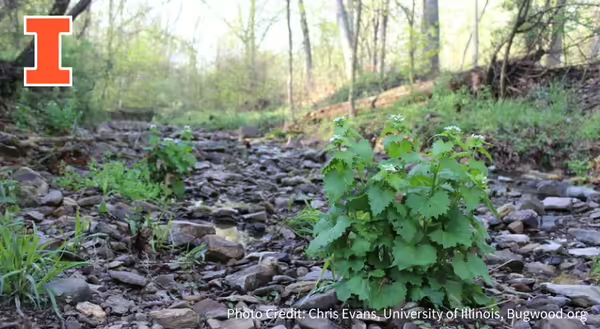
Garlic mustard, just two little words can bring a groan from naturalists across the Eastern United States. But garlic mustard, Alliaria petiolata, also known as Poor Man’s Mustard, Hedge Garlic, Garlic Root and Jack-by-the-Hedge didn’t start out in this country as a menace.
Early European settlers brought this plant with them for food and medicinal purposes. In case you were wondering, garlic mustard pesto is delicious. If you are feeling adventurous, note that garlic mustard recipes are best made with first-year growth plants that are still tender. Second-year growth tends to be a bit “woody”.
Due to its success in propagation, garlic mustard is now viewed as an invasive species. This biennial thrives in North America because it has multiple advantages.
- Early Growing Season: It is among the first plants to start “greening” up and growing in the spring. Often you can find the first-year basal rosettes, already green, in the middle of February partially covered by snow. (Removing them in the first year is the easiest.)
- Lots and lots of seeds: In its second year it produces a lot of seeds. Each plant grows pods called siliques and each plant produces on average 22 siliques. Each silique contains as many as 28 seeds. (If you do the math, that is over 600 seeds on an average plant). Some particularly robust plants can produce almost 8,000 seeds. This makes it important to remove the plant before it sets seed.
- Alleopathic chemicals: Garlic mustard makes chemical compounds call glucosinolates which inhibit the germination of native species like Black-eyed Susan, Rudbeckia hirta. These chemicals are found throughout the plant in varying degrees of concentration.
- Tolerates poor growing conditions: Garlic mustard is perfectly happy to grow in low light, disturbed habitat along forest edges and trails where trees have been removed.
- No predators: While there are numerous herbivores in its native European habitat who love to eat garlic mustard, here in North America there are no significant natural enemies.
So how do you get rid of garlic mustard?
We all know several ways to get rid of an unwanted plant, including mowing, pulling by hand or applying a chemical like glyphosate. But It is important to know that the glucosinolates produced by the plant can still leech into the ground even after it has been pulled or mowed and garlic mustard can still set seeds even if after it has been uprooted if left at the site.
The best way to eradicate small garlic mustard infestations is pulling it by hand and removing it from the scene. Quick note: don’t put it in your compost pile, it can still spread seeds.
For larger patches, refer to this Extension guide - Management of Invasive Plants and Pests of Illinois.
Explore more garlic mustard resources to get help with identification and control on the Invasive Species website.
Want to get notified when new Naturalist News posts are available? Sign up here!
ABOUT THE AUTHOR
Wendy Ferguson coordinates the Master Gardener and Master Naturalist programs in Henderson, Knox, McDonough and Warren Counties. Wendy earned a BS in Environmental Studies from Eureka College and a MS in Environmental Studies with an emphasis on writing and communication from Green Mountain College. She is interested in facilitating a deeper connection to place for community members through nature journaling and education. She is also an author for the Naturalist Notebook blog.
ABOUT THE BLOG
Naturalist News is a blog by University of Illinois Extension Master Naturalist staff and volunteers who bring you stories highlighting the individuals, places, wildlife and plants that make this state amazing. Join us each week to learn something new, be inspired and become connected to your own community by recognizing the amazing ways we are all intertwined.